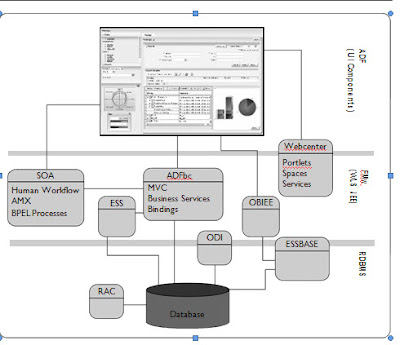Fusion Applications will use a technology platform component, Oracle Data Integrator (ODI).This will perform the Extract, Transform, Load (ETL) and Master Data Management (MDM) type functions
Comparison between EBS and Fusion Technologies
The Front End
As with most effective and seemingly simple solutions, behind the rich and intuitive Fusion Applications user interface sits a considerable amount of complexity and technology.
Application Development Framework
As mentioned earlier, Oracle’s Application Development Framework (ADF) provides most of what the business users see. The View layer, built as part of the MVC architecture, provides the user interface pages, forms, and components, with the Controller layer handling the user interaction such as button clicks (known as events).
ADF contains a taskflow mechanism that controls precisely how processes navigate from one object to another, such as page navigation and code calls.
WebCentre:
Moving aside from business logic processing and back into user interface technologies, Oracle WebCenter sits in the Fusion Middleware stack and provides several services that integrate with
⦁ WebCenter spaces and portals for management dashboards
⦁ WebCenter Composer to perform run time user personalization and more extensive customization, based on a declarative and metadata driven architecture
⦁ WebCenter Services provides various social media services, including the following:
⦁ Wiki and blog for the publication of user content
⦁ People Connection for graphically showing relationships
⦁ Tags for adding keywords to objects and data to help with searching
⦁ Instant Messaging and Presence (IMP) to promote collaborative working
Applcore
A small subset of these are uniquely provided to satisfy enterprise application requirements, and are extensions to the standard technology products. This forms a thin component layer that exists near the top of the technology stack. In Fusion Applications, this layer is known as ApplCore (Applications Core technologies).
ADFbc
Oracle’s ADF is ADF Business Components (ADFbc). It continues the support for the MVC architecture by providing a range of back-end services. Specifically, it provides the data binding capability for use in the Model layer, and it supports the creation of the components for the Business Services layer.
Enterprise Scheduling Service (ESS)
This feature provides a method of executing units of work at specific times and in specific sequences, similar to the batch processing of older enterprise resource planning (ERP) applications
Oracle Data Integrator
As mentioned, ODI’s role in the Fusion Applications technology stack is primarily based around data synchronization. ODI extends the standard ETL process of data migration into a process that first extracts and then, as one more flexible step, performs both the load and transform activities together (E-LT). ODI is also based on the SOA runtime architecture, meaning that service interactions are accomplished in the same way as the other Fusion Middle ware components; for example, ODI can be called from a BPEL process.
ODI capabilities are leveraged in several places in Fusion Applications, and the following list touches on a few:
⦁ To populate data in the BI data warehouse(OBIEE)
⦁ To migrate data from legacy systems being replaced by Fusion Applications
⦁ To synchronize common data across the Pillar Replication Framework
⦁ As part of integration to an external system (such as within a coexistence strategy)
⦁ In MDM to synchronize the single source of truth


